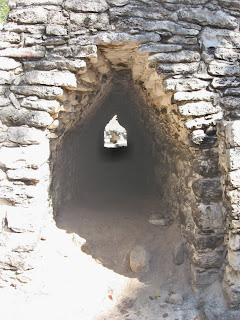Draft page.
Coba lies between two alligator infested lagoons in an area of dense woodland. The site is extensive and cycles can be hired.
The main group of structures is near the entrance and the pyramid of Nohoch Mul, the second highest in Yucatan is about two kilometres distant. The way leads past a series of structures set in the woodland, including the Conjunto de las Pinturas, the starting point of a raised causeway, and a ball court. There are several eroded stelae, showing that the site was occupied in the classic period. In some ways the style harkens back to Tikal and other sites further south, in fact in one part of the ruins there are carvings that have been identified as Queens of Tikal standing on local captives.
The Nohoch Mul is most impressive with 120 steep uneven steps. The view at the top is extensive, with the lagoon in the distance. Coba is most remarkable as being the hub of no fewer than forty sacbes or causeways, the longest running in an almost straight line for 100 Km westward to Yaxuna to the south of Chichen Itza. How they managed to engineer wide straight roads, paved with gleaming white stucco through trackless scrubby woodland with no hills to provide vantage points is a mystery. Modern Coba did not have a metalled road leading to it until the 1970s. In classic times Coba supported a population estimated at 50,000 and survived long into the post-classic period, with new constructions continuing into the 14th century.
















